Vega (European Advanced Generation Carrier)
Launchers and Propulsion
Vega (Maiden Flight of new ESA Launcher and selected Payloads)
Overview Launch Payloads VERTA Launcher Status References
Vega (Vettore Europeo di Generazione Avanzata - European Advanced Generation Carrier) is an expendable launch system developed for Arianespace jointly by the Italian Space Agency (ASI) and the European Space Agency (ESA). Italy is the leading contributor to the Vega program of ESA; other participants include France, Belgium, Spain, The Netherlands, Switzerland and Sweden. 1) 2) 3) 4)
The program began in 1998, it is managed jointly by an IPT (Integrated Project Team) composed of staff from ESA, ASI and CNES. The industrial consortium for the construction of the launcher is lead by the prime contractor ELV S.p.A. of Italy.
VEGA is designed to launch small payloads. It is composed of three solid-propellant stages and a restartable liquid-propellant fourth stage. The launcher is capable of delivering a reference payload mass of up to 1500 kg into a circular sun-synchronous orbit of 700 km altitude.
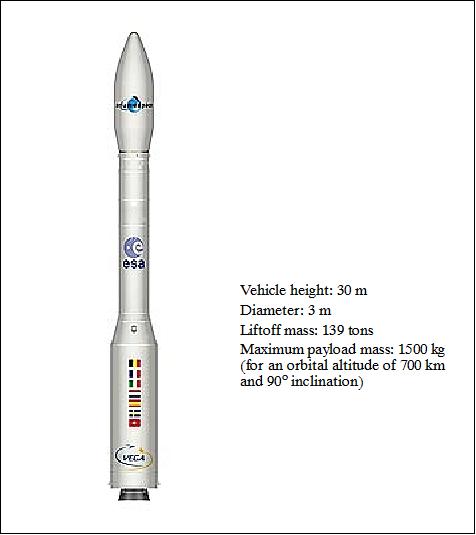
The Vega launcher is a single body vehicle composed of three SRM (Solid Rocket Motor) stages, a liquid propulsion upper module, referred to as AVUM (Attitude Vernier Upper Module), and a fairing. In a single launch configuration, Vega provides a minimum volume allocated to the payload consisting of a cylindrical volume of 2.35 m diameter and 3.5 m height plus a frustum volume of 2.8 m height. The launcher at lift-off is 30.2 m high and has a mass of 139 tons. 5) 6) 7)
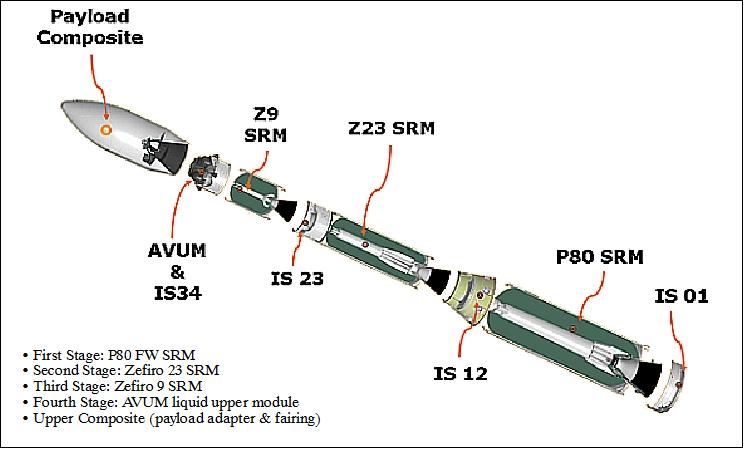
The three SRM stages perform the main scent phase while the fourth stage, the AVUM, compensates the solid propulsion performance scattering, circularizes the orbit and executes the final deorbiting maneuvers of the stage.
AVUM is itself composed of a Propulsion Module and an Avionics Module which contains three subsystems: GNC (Guidance Navigation and Control), SAS (Electric Safeguard Subsystem), and TMS (Telemetry Subsystem)). The AVUM provides attitude control and axial thrust during the final phases of Vega's flight to allow the correct orientation and orbit injection of multiple payloads. - AVUM has a dry mass of 660 kg, a propellant loading of 550 kg, a main engine thrust of 2450 N, the total impulse of the LPS (Liquid Propulsion System) is 1634 kNs, a total of 5 restarts can be provided. 8)

Vega exploitation program: In order to allow a smooth transition between development and exploitation (after the maiden flight), the VERTA (Vega Research and Technology Accompaniment) program undertakes five flexibility demonstrations flights primarily for ESA user missions. The following missions are considered for VERTA flights: ADM-Aeolus, Swarm, LISA PF (Pathfinder), PROBA-3, and IXV (Intermediate eXperimental Vehicle) reentry demonstrator.
Launch
The maiden flight of Vega, designated as VV01 (Vega Vehicle 01), took place on February 13, 2012 from Kourou in French Guiana. The first Vega lifted off at 10:00 GMT from the new launch pad, and conducted a flawless qualification flight. 9) 10)
The Vega launch operations were conducted from the spaceport's ELA-1 (Ensemble de Lancement Ariane No. 1) facility, which previously was used between 1979 and 1989 for missions with the Ariane 1 and 3 launcher versions.
• The primary scientific payload on the maiden flight was LARES (LAser RElativity Satellite) of ASI for testing a prediction following from Einstein's theory of General Relativity, the so-called ‘frame-dragging or Lense-Thirring effect'. LARES has a mass of ~400 kg. Note: LARES is described in a separate file on the eoPortal.
The launch sequence requires the following functional steps (maneuvers): 11)
1) Once the target altitude is reached (1450 km x 1450 km), the RACS (Roll Attitude Control System) of AVUM is enabled for fine stabilization mode before LARES separation: The AVUM longitudinal axis points towards the opposite direction of the orbital velocity. At the end of the pointing maneuver, the spin mode is activated. Its duration is linked to the spin rate requirements that for LARES shall be around 5 rpm.
2) The LARES payload is separated and deployed through the LARES separation system providing a delta velocity of about 0.75 m/s ± 20%.
Orbit of LARES: Circular orbit, altitude = 1450 km x 1450 km, inclination = 71º,
3) After the LARES separation, RACS is switched on again for a despin maneuver, required to demonstrate the RACS functional capability.
4) The third an final ignition of AVUM is activated to perform a de-orbiting phase, in which AVUM reaches the stable orbit of 1450 x 354 km, compliant with the Space Debris Mitigation regulations (natural de-orbit within < 25 years)
5) After the de-orbiting boosting phase, ALMASAT is separated and then the three CubeSat deployers (P-PODs) are activated to release the seven microsatellites.
Orbit of all secondary payloads: Elliptical orbit, altitude of 354 km x 1450 km, inclination = 71º, orbital period = 103 minutes (14 revolutions/day). About 75% of the orbit is in sunlight.
The secondary payload flown consisted of 7 CubeSats and 1 microsatellite, AlmaSat, of the University of Bologna, Italy.
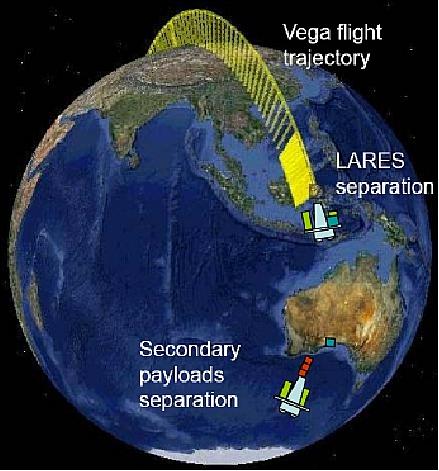
Organizational Links
The key players involved in the Vega maiden flight are: 12)
- the Vega integrated project team (Vega-IPT)
- the LARES System (ASI and their industrial contractor, Carlo Gavazzi Space)
- the Hands-on Projects Unit of the ESA Education Office (LEX-EP)
- the 7 CubeSat teams
- the P-POD developers (Cal Poly)
The ESA Education Office is responsible for:
- the technical and programmatic coordination of the CubeSat teams
- the definition of the requirements which are made applicable to the CubeSats development to ensure their compatibility with the P-PODs, the LARES system, and with Vega
- organizing and conducting the reviews for the CubeSats integration with the P-PODs
- performing the physical and analytical integration of the CubeSats with the P-PODs (with the support of the P-POD developer, i.e. Cal Poly)
- performing the final verification of the P-PODs integrated with the CubeSats
- preparing the acceptance data packages of the P-PODs/CubeSats, to be submitted to the LARES system integrator and to Vega.

ESA, with the technical support of the Italian and French space agencies, and about 40 industrial companies coordinated by the prime contractor ELV SpA, have made this enormous challenge a reality in under a decade of development.
Payloads
Secondary Payloads Selected for First Qualification Flight in 2006
Vega's qualification launch (maiden flight) features the following secondary payload elements:
• Technology payload: The main passenger on the maiden flight will be an adaptation from the existing Upper Composite test dummy used during the Upper Composite mechanical test campaign held at ESTEC in 2006. The technology payload will be fitted with a variety of sensors to characterize the environmental parameters and demonstrate conformance with the specifications.
• ALMASat-1, a lightweight microsatellite (12.5 kg) of the University of Bologna, Italy, is also part of the Vega payload.
• An educational payload of nine European CubeSats is foreseen to be accommodated in three PODs (Picosatellite Orbital Deployers), each containing three CubeSats, attached to and deployed from the qualification payload. The launch opportunity on the Vega Maiden Flight is offered free of charge by ESA. 13) 14) 15) 16)
The CubeSats for the Vega maiden flight were selected by the ESA Education Office at ESA/ESTEC in June 2008, upon completion of the selection process initiated in February 2008 with the release of an announcement of opportunity to launch CubeSats on board the VEGA Maiden Flight. Nine CubeSats (plus two backups, from 22 proposals submitted) from European universities. The selected CubeSats are: 17) 18)
1) AtmoCube (University of Trieste, Italy): in-situ monitoring of space environment parameters such as radiation flux, magnetic field and atmospheric density
2) e-st@r (Politecnico di Torino, Italy): demonstration of an active 3-axis Attitude Determination and Control system including an inertial measurement unit
3) Goliat (University of Bucharest, Romania): imaging of the Earth surface using a digital camera and in-situ measurement of radiation dose and micrometeoroid flux
4) OUFTI-1 (University of Liege, Belgium): a mission to test the use of the D-STAR amateur radio digital communication protocol in space
5) PW-Sat (Warsaw University of Technology, Poland): a mission to test a deployable atmospheric drag augmentation device for de-orbiting CubeSats.
Two backup CubeSats were selected in case any of the primary CubeSats are not able to fulfil the requirements of the launch opportunity. They are:
6) Robusta (University of Montpellier 2, UM2, France): a mission to test and evaluate radiation effects (low dose rate) on bipolar transistor electronic components
7) UNICubeSat (University of Rome, La Sapienza, Italy): performing in-situ measurements of atmospheric neutral density using the Broglio drag balance instrument
8) UWE-3 (University of Würzburg, Germany): demonstration of an active 3-axis Attitude Determination and Control system using magnetorquers
9) Xatcobeo (a collaboration of the University of Vigo and INTA, Spain): a mission to demonstrate software-defined radio and solar panel deployment
10) HiNCube (Narvik University College, Norway): imaging of the Earth surface using a digital camera (backup).
11) SwissCube-2 (Ecole Polytechnique Federale de Lausanne, Switzerland): a mission to characterize the air glow phenomenon in the Earth's atmosphere (low priority backup).
All payloads will be described in separate files on the eoPortal as the information becomes available.
CubeSat Passenger Payloads Flown on the Maiden Flight of Vega
Although ESA's Education Office was providing 9 CubeSat positions on the maiden flight of Vega, only 7 CubeSats were confirmed as of December 2011 (Ref. 20). Not all universities that were were preselected for the launch opportunity in June 2008, were able to deliver their CubeSat and the requested documentation. Other CubeSat projects, like SwissCube and HiNCube, decided to be launched on commercial flights.
Overview of the CubeSat passenger payloads flown on the Vega-1 mission (Ref. 19), 20), 21))
• Xatcobeo (a collaboration of the University of Vigo and INTA, Spain): a mission to demonstrate software-defined radio and solar panel deployment
• Robusta (University of Montpellier 2, France): a mission to test and evaluate radiation effects (low dose rate) on bipolar transistor electronic components
• e-st@r (Politecnico di Torino, Italy): demonstration of an active 3-axis Attitude Determination and Control system including an inertial measurement unit
• Goliat (University of Bucharest, Romania): imaging of the Earth surface using a digital camera and in-situ measurement of radiation dose and micrometeoroid flux
• PW-Sat (Warsaw University of Technology, Poland): a mission to test a deployable atmospheric drag augmentation device for de-orbiting CubeSats
• MaSat-1 (Budapest University of Technology and Economics): a mission to demonstrate various spacecraft avionics, including a power conditioning system, transceiver and on-board data handling.
• UniCubeSat GG (Universitá di Roma ‘La Sapienza', Italy): the main mission payload concerns the study of the gravity gradient (GG) enhanced by the presence of a deployable boom.
Feb. 13. 2012: All of Vega's three solid-propellant stages performed as planned. The upper stage maneuvered to reach a circular orbit at an altitude of 1450 km inclined at 69.5º to the equator. There, it released the primary payload, the LARES laser relativity satellite, a 37.6 cm diameter sphere of tungsten alloy fitted with 92 laser retroreflectors. The mirrors will allow high-precision distance measurements to study a ‘frame-dragging' effect predicted by Einstein's theory of relativity. 22)
The upper stage then maneuvered again to reduce the orbit's lowest point to 350 km, to the correct orbit for release of the ALMASat-1 technology microsatellite and the seven tiny university-sponsored picosatellites.
During the VV01 mission, a large amount of data was collected on Vega's performance, as well as the environment experienced by the payloads. This information will be analyzed in depth to confirm the full qualification of the Vega launch system, which will then be handed over to Arianespace for marketing and operations.
New technologies for large solid-propellant motors were demonstrated under flight conditions by the P80FW first stage. As the largest monolithic solid-propellant motor ever flown, it features a composite casing, an advanced nozzle and electromechanical actuators for steering – a world first for a motor of that size.
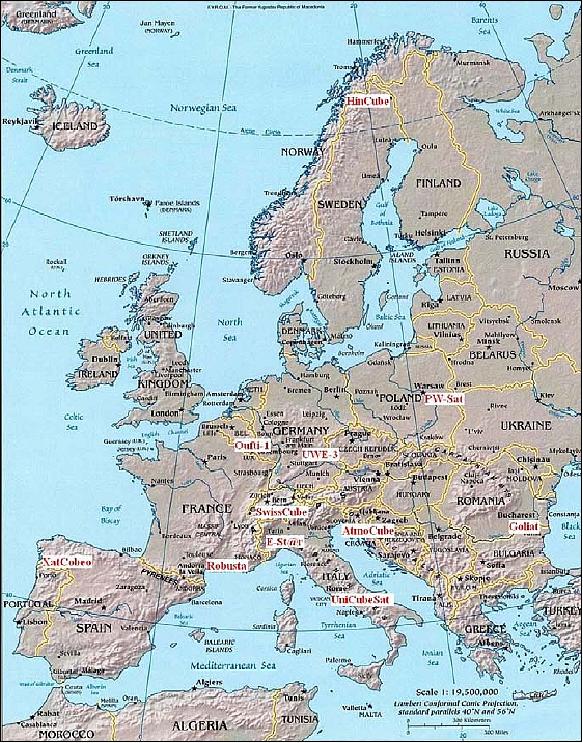
VERTA (Vega Research, Technology and Accompaniment)
After the maiden flight, Vega enters the VERTA program. Under VERTA, Vega will launch various science and technology missions. The VERTA program has three main components: 23)
• Procurement of five launches (VERTA demonstration flights)
• Customer Service Improvement activities
• Production accompaniment and technological activities.
The next flight is scheduled for early 2013 carrying ESA's PROBA-V (Project for On-Board Autonomy - Vegetation) remote sensing satellite and multiple auxiliary payloads.
The VERTA flights will carry four ESA missions: PROBA-V, ADM/Aeolus, LISA Pathfinder, and the Intermediate Experimental Vehicle (IXV).
AD-SS (ADapter and Separation System)
The experience gained during the development and the qualification for the launch of the ALMASat-1 AD-SS (ADapter and Separation System) on the Vega maiden flight (launch Feb. 13, 2012), and the launch results led to a joint activity of ALMASpace with the European Space Agency aimed at the development of a wider series of adapters and separation systems based on the same design philosophy adopted for the ALMASat-1 AD-SS. 24) 25)
The target of the new series of AD-SS is the class of spacecraft up to 200 kg mass and separation velocity up to 2 m/s, with the planned development of different configurations to achieve the best trade-off between performance and costs of the AD-SS 200 model characterized by four clamping systems.
The AD-SS 200 configuration shares the same features and advantages derived from the ALMASat-1 experience:
• Tunable and calibrated separation system, allowing to vary the separation velocity from 0 up to 2 m/s
• No pyrotechnical devices involved
• Reduced refurbishing and inspection time during ground operations
• Separation switches for detachment detection included
• Standard LV/SC interfaces.
Separation system: The separation systems, previously mounted on the internal surface of the AD-SS canister (Figure 7) has been embedded in the structure, with the possibility to insert enhanced linear guides, provided by SKF, guiding the separation pads during the entire extension of the four springs, avoiding any undesired lateral forces acting on the spacecraft.
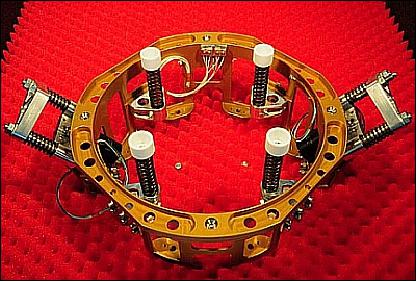
Clamping system: The clamping system for AD-SS 200 has been re-designed to reduce the volume envelope, to reduce the related stay-out zone and also to reduce the leverage of the clamping pins, therefore enhancing the robustness of the entire system. Moreover four guiding pins have been added in order to reduce the effect of degraded release conditions caused by the excessive AVUM angular rate (Figure 8).

Adapter ring: As illustrated in Figure 8, the interface between the spacecraft and the AD-SS 200 is represented by an adapter ring. In order to adapt the AD-SS to a wide range of mission scenarios and spacecraft, custom adapter rings can be manufactured and installed upon customer request provided its compatibility with AD-SS 200 and spacecraft requirements. In Figure 9, the specific adapter rings for PROBA-V and TDS-1 satellites are shown.
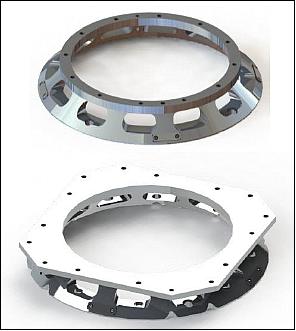
The implementation of an adapter ring as interface between the spacecraft and the AD-SS facilitate the installation of brackets for the umbilical connectors as shown in Figure 10.

Retaining torque: The actuation philosophy selected for the release of the spacecraft from the AD-SS 200 consists in the non-simultaneous opening of the two pairs of clamps, in order to reduce the overall power needed if four NEAs were to be actuated simultaneously.
According to this solution, the first pair of clamps will be initially opened, not affecting the spacecraft positioning on the adapter; successively at the instant of the opening of the second pair of clamps, the spacecraft is left free to separate from the adapter. This solution is made possible by the applied preload and each clamp is sized to be able to guarantee the required torque to retain the spacecraft in the closed position until the last clamp is opened by the separation command.
AD-SS final design: Figure 11 shows the final design of the AD-SS 200 system. The differences with respect the previous model are the number of the clamping systems included (four instead of two) and the load capacity of NEAs included.
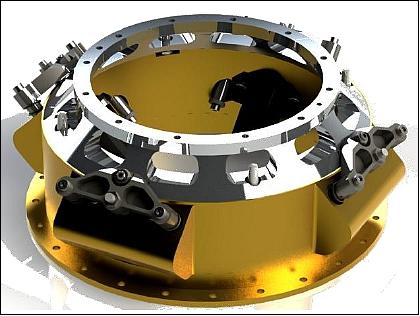
Maximum payload deployment mass of AD-SS 200 | 200 kg |
Separation velocity (@ max. P/L mass) | up to 2 m/s |
Voltage supply | 22 V |
Internal resistance | 2.4 Ohm @ 23ºC |
Current supply | 8.75 A (each NEA) |
Power supply | 770 W |
Actuation time | 20 ms @ 23ºC |
Expected scatter | ± 7 ms @ 23ºC |
Launcher Status
• December 11, 2015: Europe's Vega light launcher is entering its commercial life boasting a flawless record and an impressive set of capabilities for a wide range of missions. Vega scored its sixth straight success with the launch of ESA's LISA Pathfinder scientific craft earlier this month, having already lofted payloads for Earth observation, space engineering and exploration. Operator Arianespace has now taken over full responsibility for Vega's commercial exploitation at Europe's Spaceport in Kourou, French Guiana. 26)
- Such is the market confidence in Vega that nine of the 10 vehicles ordered by Arianespace from prime contractor ELV in November 2013 are already assigned to customers.
- In 2016, Vega is scheduled to launch a dual mission carrying PeruSat-1, a Peruvian imaging satellite and four passenger payloads for Skybox Imaging. Turkey's Göktürk-1 Earth observation satellite is also planned for launch before the end of the year.
- Vega is the ideal launcher for small scientific and Earth observation payloads of 300–2500 kg operating in polar and LEO (Low Earth Orbit), but it achieved much more than this during its demonstration phase. Following Vega's debut in February 2012, ESA's VERTA (Vega Research and Technology Accompaniment Program) has shown a range of capabilities and flexibility.
• The second Vega launch took place on 7 May 2013 from French Guiana. It marks the transition into commercial exploitation while still completing its qualification. This launcher with increased capabilities and flexibility is designed to meet the demands of the launchers market. The extended capabilities of Vega beyond the mission that was performed in the VV01 qualification flight have been made possible in part by the addition of VESPA (VEga Secondary Payload Adapter). VESPA allows for multiple payloads and their deployment into different orbits. 27)
- Compared to the first Vega launch, with VV02 there was a change in both inclination and orbit for the satellites. This is a complex procedure and resulted in a much longer mission – at 160 minutes it is more than double that of VV01.
- PROBA-V minisatellite was the first payload released by VESPA into a Sun-synchronous polar orbit at 820 km altitude and an inclination of 98.73° (launch on May 7, 2013). At this point, the VESPA adapter separated and Vega then, through a series of five burns and coasts, moved into a second orbit at 668 km altitude and an inclination of 98.13° for the second deployment of the two remaining payloads. — The PROBA-V minisatellite for Earth observation was mounted on top of VESPA (Figure 12) , which housed two passengers inside, ESTCube-1 and VNREDSat-1A – Vega's first commercial payload. A final burn of Vega's fourth stage also highlighted its ability to drop out of orbit to reduce the threat of space debris.
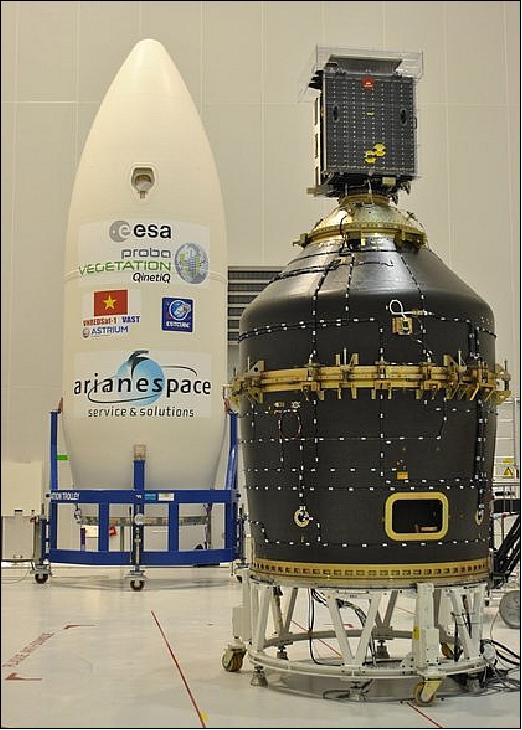
• On February 11, 2015, Vega lofted the IXV (Intermediate eXperimental Vehicle) spaceplane to test autonomous reentry for future space transportation. Instead of a polar path used on previous Vega missions, IXV required a suborbital equatorial trajectory to allow splashdown in the Pacific Ocean after 100 minutes. At almost two tons, IXV came close to Vega's payload capacity and took up most of the space inside the protective fairing.
- With VERTA completed, ESA's LEAP (Launchers Exploitation Accompaniment Program) will ensure that Vega remains operational and that further improvements will reduce launch service costs.
References
1) http://en.wikipedia.org/wiki/Vega_(rocket)
2) http://www.esa.int/SPECIALS/Launchers_Access_to_Space/SEMH3E67ESD_0.html
3) M. Lopez, "VEGA: Status of the Development Activities and Future Perspectives," July 3, 2009, URL: [web source no longer available]
4) Agostino Neri, "Vega Launch System, Final Preparation for Qualification Flight," 47th AIAA JPC (Joint Propulsion Conference) 2011, San Diego,CA, USA, Aug. 4, 2011, URL: [web source no longer available]
5) Stefano Bianchi, and the Vega Integrated Project Team (IPT), "VEGA: Status of the Development Activities and Future Perspectives," Proceedings of the 60th IAC (International Astronautical Congress), Daejeon, Korea, Oct. 12-16, 2009, IAC-09.D2.1.5
6) Caroline Arnoux, Serge Chartoire, "Vega launch services for small satellite programs," Proceedings of the 60th IAC (International Astronautical Congress), Daejeon, Korea, Oct. 12-16, 2009, IAC-09.D2.2.3
7) "The Small Launcher for Europe," ESA Brochure BR-257, November 2005, URL: http://esamultimedia.esa.int/docs/VEGA.pdf
8) "Building Vega meant testing materials to their limits," ESA, March 9, 2012, URL: http://www.esa.int/SPECIALS/Space_Engineering/SEMQT82YRYG_0.html
9) "ESA's new Vega launcher scores success on maiden flight," ESA, Feb. 13, 2012, URL: http://www.esa.int/SPECIALS/Vega/SEMJ8LYXHYG_0.html
10) "VEGA: mission accomplished!," ASI, Feb. 13, 2012, URL: http://www.asi.it/en/news_en/vega_mission_accomplished_0
11) Ignazio Ciufolini, Antonio Paolozzi, Giampiero Sindoni, Erricos C. Pavlis, Alessandro Gabrielli, "Scientific and Engineeristic Aspects of LARES Mission, Proceedings of the 60th IAC (International Astronautical Congress), Daejeon, Korea, Oct. 12-16, 2009, IAC-09.B4.2.9
12) P. C. Galeone, J. Fromm Pedersen, "CubeSats for the Vega Maiden Flight," Proceedings of the Symposium on Small Satellite Systems and Services (4S), Funchal, Madeira, Portugal, May 31-June 4, 2010
13) Jakob Fromm Pedersen, "CubeSat Educational Payload on the Vega Maiden Flight, Interface Control Document," ESA/ESTEC, Feb. 13, 2009, URL: http://www.ies.univ-montp2.fr/robusta/satellite/IMG/pdf/SP_GN_2009.02.13_ICD.pdf
14) "Educational Payload on the Vega Maiden Flight Call For CubeSat Proposals," ESA, Issue 1, Revision 1, February 25, 2008, URL: http://esamultimedia.esa.int/docs/LEX-EC/CubeSat_CFP_issue_1_rev_1.pdf
15) Piero Galeone, Jakob Fromm Pedersen, "CubeSats for the VEGA Maiden Flight," Proceedings of the 7th Annual CubeSat Developers' Workshop, Cal Poly, San Luis Obispo, CA, USA, April 21-23, 2010, URL: http://cubesat.calpoly.edu/images/cubesat/presentations/DevelopersWorkshop2010/1340_
cubesats_for_the_vega_maiden_flight.pdf
16) P. C. Galeone, R. Walker, H. Page, "The Hands-on Projects of the ESA Education Office," Proceedings of the Symposium on Small Satellite Systems and Services (4S), Funchal, Madeira, Portugal, May 31-June 4, 2010
17) https://web.archive.org/web/20200217002601/http://www.ne.jp:80/asahi/hamradio/je9pel/esa9cube.htm
18) http://dtusat.dtu.dk/index.php?id=108
19) "ESA's CubeSats ready for flight," ESA, Dec. 16, 2011, URL:
http://www.esa.int/SPECIALS/Education/SEMG1C8XZVG_0.html
20) "ESA Cubs delivered for first Vega flight," ESA, Nov. 14, 2011, URL: http://www.esa.int/esaMI/Education/SEM3L0WWVUG_0.html
21) "ESA's CubeSats near the end of a five year journey," ESA, Jan. 26, 2012, URL: http://www.esa.int/SPECIALS/Education/SEMV4RH8RXG_0.html
22) http://www.esa.int/esaCP/SEMSDLYXHYG_index_0.html
23) "Vega Research and Technology Accompaniment Program Extension 2011-2012," URL: http://esamultimedia.esa.int/docs/MinisterialCouncil/MC-VERTA_1811.pdf
24) Alberto Corbelli, Davide Bruzzi, Paolo Tortora, Marco Bocciarelli, Benoit Geffroy, "The Adapter and Separation Systems Series for the Vega Launch Vehicle," Proceedings of the 4S (Small Satellites Systems and Services) Symposium, Portoroz, Slovenia, June 4-8, 2012
25) Davide Bruzzi, Alberto Corbelli, Paolo Tortora, Marco Bocciarelli, Benoit Geffroy, "The adapter and separation systems series for the VEGA launch vehicle," Proceedings of the 63rd IAC (International Astronautical Congress), Naples, Italy, Oct. 1-5, 2012, paper: IAC-12-B4.5.10
26) "Vega graduates with perfect record," ESA, Dec. 11, 2015, URL: http://www.esa.int/Our_Activities/Launchers/Vega_graduates_with_perfect_record
27) "Vega," ESA, May 10, 2013, URL: http://www.esa.int/Our_Activities/Launchers/Launch_vehicles/Vega
Overview Launch Payloads VERTA Launcher Status References Back to top